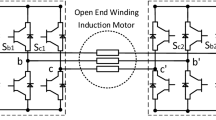Abstract
In recent years several discontinuous pulse width modulation (DPWM) methods are reported to improve the performance of AC drives at high modulation indices. It is proved that the performance of the popular PWM methods is modulation index dependent and no single DPWM method provides satisfactory performance over the entire high modulation range. Two popular existing DPWM methods renowned with the names DPWMMIN, DPWMMAX clamp each phase for 120° duration in every cycle of its fundamental voltage. It is observed that only the zero state is different in these two sequences. In this paper, it is proposed that, utilizing these two DPWM sequences and by changing the zero state at any spatial angle γ, where γ is between 0° and 60°, an infinite number of DPWM sequences including the existing DPWM methods and advanced DPWM (ADPWM) methods can be generated which are categorized as “continual clamping” and “split clamping” sequences. Using these ADPWM techniques an optimal split clamping sequence-based DTC of induction motor is proposed. With the proposed DTC method it is shown that steady state line current distortion at higher line side voltages is reduced significantly compared with the CDTC as well as conventional SVPWM (CSVPWM)-based DTC.
Similar content being viewed by others
References
Blaschke F (1972) The principle of field orientation as applied to the new TRANSVECTOR closed loop control system for rotating field machines. Siemens Rev XXXIX 5: 217–220
Takahashi I, Noguchi T (1986) A new quick-response and high efficiency control strategy of an induction motor. IEEE Trans Ind Appl IA-22(5): 820–827
Titinen P, Surandra M (1996) The next generation motor control method, DTC direct torque control. IEEE Proc Power Electron Drives Energy Syst Ind Growth 1: 37–43
Holtz J (1992) Pulsewidth modulation: a survey. IEEE Trans Ind Electr 39(5): 410–420
Holtz J (1994) Pulsewidth modulation for electronic power conversion. Proc IEEE 82(8): 1194–1214
Narayanan G, Ranganathan VT (1999) Synchronized PWM strategies based on space vector approach. Part 1: principles of waveform generation. Proc Inst Electron Eng 146(3): 267–275
Zhou K, Wang D (2002) Relationship between space-vector modulation and three-phase carrier-based PWM: a comprehensive analysis. IEEE Trans Ind Electron 49(1): 186–196
Holmes DG, Lipo TA (2003) Pulse width modulation for power converters: principle and practice. Wiley, New York
Habetler TG et al (1992) Direct torque control of induction machines using space vector modulation. IEEE Trans Ind Appl 28(5): 1045–1053
Tang L, Zhong L, Rahman MF, Hu Y (2002) An investigation of a modified direct torque control strategy for flux and torque ripple reduction for induction machine drive system with fixed switching frequency. IEEEIAS, pp 837–844
Chung D-W, Kim J-S, Sul S-K (1998) Unified voltage modulation technique for real-time three-phase power conversion. IEEE Trans Ind Appl 34(2): 374–380
Hava AM, Kerkman RJ, Lipo TA (1998) A high performance generalized discontinuous PWM algorithm. IEEE Trans Ind Appl 34(5): 1059–1071
Hava AM, Kerkman RJ, Lipo TA (1999) Simple analytical and graphical methods for carrier-based PWM-VSI drives. IEEE Trans Power Electron 4(1): 49–61
Ojo O (2004) The generalized discontinuous PWM scheme for three-phase voltage source inverters. IEEE Trans Ind Electron 51(6): 1280–1289
Brahmananda Reddy T, Amarnath J, Subba Rayudu D, Haseeb Khan Md (2006) Generalized discontinuous PWM based direct torque controlled induction motor drive with a sliding mode speed controller. IEEE Proc Power Electron Drives Energy Syst Indu Growth, PEDES’06, New Delhi, India, paper no. 3D-11
Narayanan G, Ranganathan VT (2005) Analytical evaluation of harmonic distortion in PWM AC drives using the notion of stator flux ripple. IEEE Trans Power Electron 20(2): 466–474
Narayanan G, Krishnamurthy HK, Di Zhao, Ayyanar R (2006) Advanced bus-clamping PWM techniques based on space vector approach. IEEE Trans Power Electron 21(4): 974–984
Brahmananda Reddy T, Amarnath J, Subba Rayudu D (2006) New hybrid SVPWM methods for direct torque controlled induction motor drive for reduced current ripple. IEEE Proc Power Electron Drives Energy Syst Ind Growth, PEDES’06, New Delhi, India, Paper no. 3B-20
Author information
Authors and Affiliations
Corresponding author
Rights and permissions
About this article
Cite this article
Sri Gowri, K., Reddy, T.B. & Sai Babu, C. Direct torque control of induction motor based on advanced discontinuous PWM algorithm for reduced current ripple. Electr Eng 92, 245–255 (2010). https://doi.org/10.1007/s00202-010-0182-2
Received:
Accepted:
Published:
Issue Date:
DOI: https://doi.org/10.1007/s00202-010-0182-2




